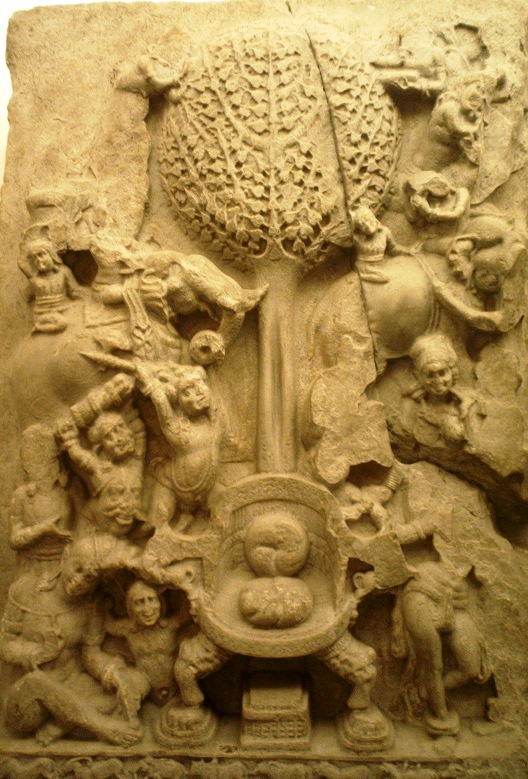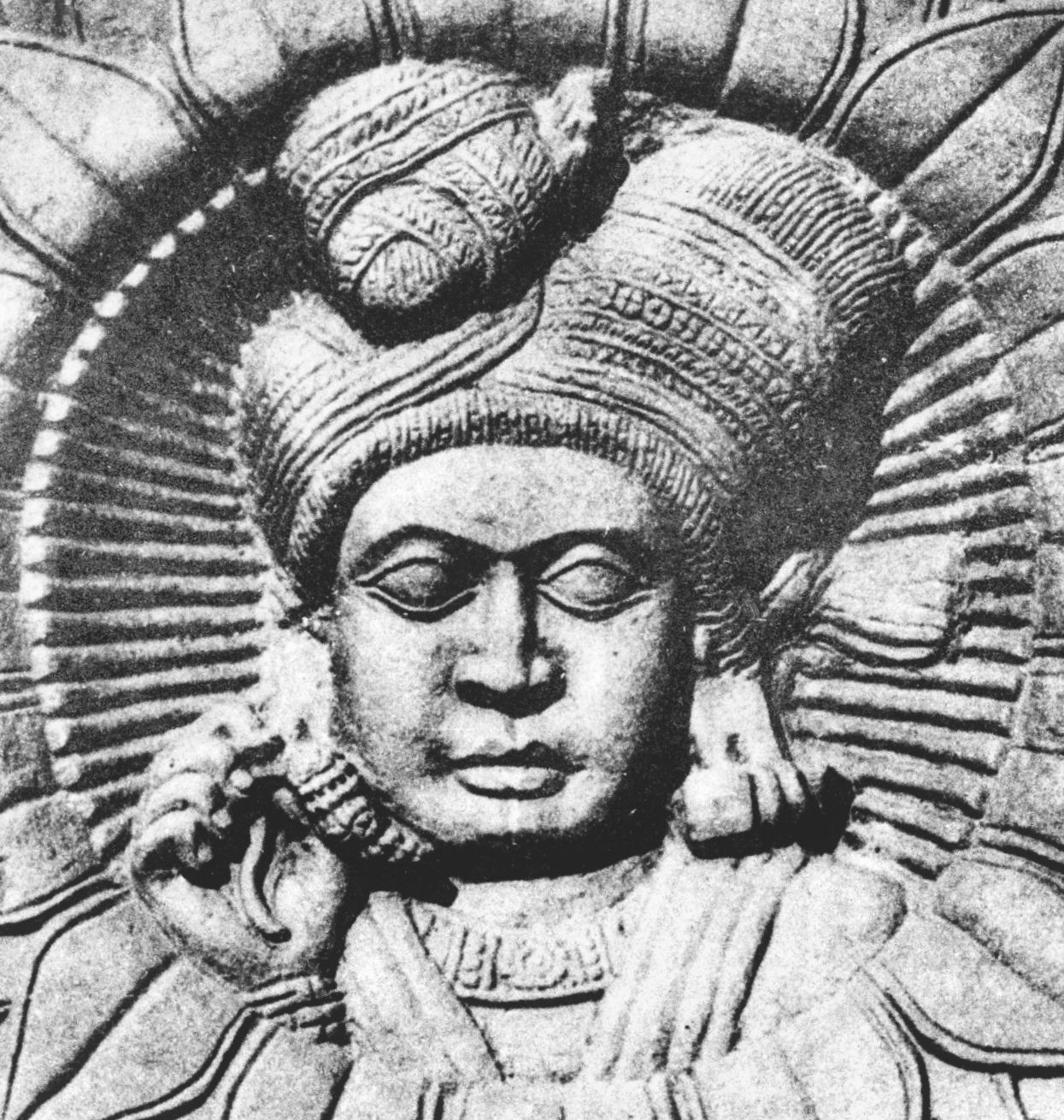|
Sanchi Stupa No. 2
The Stupa No. 2 at Sanchi, also called Sanchi II, is one of the oldest existing Buddhist stupas in India, and part of the Buddhist complex of Sanchi in Madhya Pradesh. It is of particular interest since it has the earliest known important displays of decorative reliefs in India, probably anterior to the reliefs at the Mahabodhi Temple in Bodh Gaya, or the reliefs of Bharhut.Alexander Peter Bell ''Didactic Narration: Jataka Iconography in Dunhuang with a Catalogue of Jataka Representations in China''. LIT Verlag Münster, 200p.15ff/ref> It displays what has been called "the oldest extensive stupa decoration in existence"."The railing of Sanchi Stupa No.2, which represents the oldest extensive stupa decoration in existence, (and) dates from about the second century B.C.E" John Clifford Holt, Jacob N. Kinnard & Jonathan S. Walters, ''Constituting Communities: Theravada Buddhism and the Religious Cultures of South and Southeast Asia''. SUNY Press, 201p.197/ref> Stupa II at Sanchi is ... [...More Info...] [...Related Items...] OR: [Wikipedia] [Google] [Baidu] |
Sanchi
Sanchi Stupa is a Buddhist art, Buddhist complex, famous for its Great Stupa, on a hilltop at Sanchi Town in Raisen District of the States and territories of India, State of Madhya Pradesh, India. It is located, about 23 kilometers from Raisen, Raisen town, district headquarter and north-east of Bhopal, capital of Madhya Pradesh. The Great Stupa at Sanchi is one of the oldest stone structures in India, and an important monument to the historical architecture of India. It was originally commissioned by the Maurya Empire, Mauryan emperor Ashoka the Great, Ashoka in the 3rd century BCE. Its nucleus was a simple hemispherical brick structure built over the relics of the Gautama Buddha, Buddha. It was crowned by the Chatra (umbrella), chatra, a parasol-like structure symbolising high rank, which was intended to honour and shelter the relics. The original construction work of this stupa was overseen by Ashoka, whose wife Devi was the daughter of a merchant of nearby Vidisha. Sanchi ... [...More Info...] [...Related Items...] OR: [Wikipedia] [Google] [Baidu] |
Kharoshthi
Kharosthi script (), also known as the Gandhari script (), was an ancient script originally developed in the Gandhara Region of modern-day Pakistan, between the 5th and 3rd century BCE. used primarily by the people of Gandhara alongside various parts of South Asia and Central Asia. it remained in use until it died out in its homeland around the 5th century CE. It was also in use in Bactria, the Kushan Empire, Sogdia, and along the Silk Road. There is some evidence it may have survived until the 7th century in Khotan and Niya, both cities in East Turkestan. History The name Kharosthi may derive from the Hebrew ''kharosheth'', a Semitic word for writing, or from Old Iranian ''*xšaθra-pištra'', which means "royal writing". The script was earlier also known as ''Indo-Bactrian script'', ''Kabul script'' and ''Arian-Pali''. Scholars are not in agreement as to whether the Kharosthi script evolved gradually, or was the deliberate work of a single inventor. An analysis of the ... [...More Info...] [...Related Items...] OR: [Wikipedia] [Google] [Baidu] |
Gandhara
Gandhara () was an ancient Indo-Aryan people, Indo-Aryan civilization in present-day northwest Pakistan and northeast Afghanistan. The core of the region of Gandhara was the Peshawar valley, Peshawar (Pushkalawati) and Swat valleys extending as far east as the Pothohar Plateau in Punjab, though the cultural influence of Greater Gandhara extended westwards into the Kabul, Kabul valley in Afghanistan, and northwards up to the Karakoram range. The region was a central location for the Silk Road transmission of Buddhism, spread of Buddhism to Central Asia and East Asia with many Chinese Buddhism, Buddhist pilgrims visiting the region. Between the third century BCE and third century CE, Gandhari language, Gāndhārī, a Middle Indo-Aryan languages, Indo-Aryan language written in the Kharosthi script and linked with the modern Dardic languages, Dardic language family, acted as the lingua franca of the region and through Buddhism, the language spread as far as China based on Gandhār ... [...More Info...] [...Related Items...] OR: [Wikipedia] [Google] [Baidu] |
Prolegomenon
In an essay, article, or book, an introduction (also known as a prolegomenon) is a beginning section which states the purpose and goals of the following writing. This is generally followed by the body and conclusion. Common features and techniques The introduction typically describes the scope of the document and gives a brief explanation or a summary of the document. It may also explain certain elements that are important to the document. The readers can thus have an idea about the following text before they actually start reading it. The University of Toronto provides advice about how to write essays: A good introduction should identify your topic, provide essential context, and indicate your particular focus in the essay. It also needs to engage your readers’ interest. Some authors write their introduction first, while others prefer to leave it for a later stage in the writing process; another option is to start with a rough draft introduction, and then come back to fini ... [...More Info...] [...Related Items...] OR: [Wikipedia] [Google] [Baidu] |
Aniconic
Aniconism is the cultural absence of artistic representations (''icons'') of the natural and supernatural worlds, or it is the absence of representations of certain figures in religions. The prohibition of material representations may only extend to a specific supreme deity, or it can encompass an entire pantheon, it can also include depictions of a prophet, saints, or sages, or even depictions of living beings and anything in existence generally. It is generally codified by religious traditions and as such, it becomes a taboo. When it is enforced by the physical destruction of images, aniconism becomes iconoclasm. Aniconism has historical phases in both Buddhism and Christianity, though these movements have been largely rejected as Buddha in art, life of Buddha in art, Buddhas and bodhisattvas in art, God the Father in Western art, Holy Spirit in Christian art, the depiction of Jesus, The Trinity in art, and are common. By contrast Islam has predominantly been aniconist ... [...More Info...] [...Related Items...] OR: [Wikipedia] [Google] [Baidu] |
Sunga Railings Detail
The Shunga Empire (IAST: ') was a ruling entity centred around Magadha and controlled most of the northern Indian subcontinent from around 187 to 75 BCE. The dynasty was established by Pushyamitra, after taking the throne of Magadha from the Mauryas. The Shunga empire's capital was Pataliputra, but later emperors such as Bhagabhadra also held court at Besnagar (modern Vidisha) in eastern Malwa. This dynasty is also responsible for successfully fighting and resisting the Greeks in Shunga–Greek War. Pushyamitra ruled for 36 years and was succeeded by his son Agnimitra. There were ten Shunga rulers. However, after the death of Agnimitra, the second king of the dynasty, the empire rapidly disintegrated:K.A. Nilkantha Shastri (1970)''A Comprehensive History of India: Volume 2'' p.108: "Soon after Agnimitra there was no 'Sunga empire'." inscriptions and coins indicate that much of northern and central India consisted of small kingdoms and city-states that were independent of any S ... [...More Info...] [...Related Items...] OR: [Wikipedia] [Google] [Baidu] |
Bodhisattva
In Buddhism, a bodhisattva is a person who has attained, or is striving towards, '' bodhi'' ('awakening', 'enlightenment') or Buddhahood. Often, the term specifically refers to a person who forgoes or delays personal nirvana or ''bodhi'' in order to compassionately help other individuals reach Buddhahood. In the Early Buddhist schools, as well as modern Theravāda Buddhism, bodhisattva (or bodhisatta) refers to someone who has made a resolution to become a Buddha and has also received a confirmation or prediction from a living Buddha that this will come to pass. In Theravāda Buddhism, the bodhisattva is mainly seen as an exceptional and rare individual. Only a few select individuals are ultimately able to become bodhisattvas, such as Maitreya. In Mahāyāna Buddhism, a bodhisattva refers to anyone who has generated '' bodhicitta'', a spontaneous wish and compassionate mind to attain Buddhahood for the benefit of all sentient beings. Mahayana bodhisattvas are spiritua ... [...More Info...] [...Related Items...] OR: [Wikipedia] [Google] [Baidu] |
Sanchi Stupa Number 2 KSP 3638
Sanchi Stupa is a Buddhist art, Buddhist complex, famous for its Great Stupa, on a hilltop at Sanchi Town in Raisen District of the States and territories of India, State of Madhya Pradesh, India. It is located, about 23 kilometers from Raisen, Raisen town, district headquarter and north-east of Bhopal, capital of Madhya Pradesh. The Great Stupa at Sanchi is one of the oldest stone structures in India, and an important monument to the historical architecture of India. It was originally commissioned by the Maurya Empire, Mauryan emperor Ashoka the Great, Ashoka in the 3rd century BCE. Its nucleus was a simple hemispherical brick structure built over the relics of the Gautama Buddha, Buddha. It was crowned by the Chatra (umbrella), chatra, a parasol-like structure symbolising high rank, which was intended to honour and shelter the relics. The original construction work of this stupa was overseen by Ashoka, whose wife Devi was the daughter of a merchant of nearby Vidisha. Sanchi ... [...More Info...] [...Related Items...] OR: [Wikipedia] [Google] [Baidu] |
Mogaliputa Tissa
Moggaliputtatissa (ca. 327–247 BCE), was a Buddhist monk and scholar who was born in Pataliputra, Magadha (now Patna, India) and lived in the 3rd century BCE. He is associated with the Third Buddhist council, the Mauryan emperor Ashoka and the Buddhist missionary activities which took place during his reign. Moggaliputtatissa is seen by the Theravada Buddhist tradition as the founder of " ''Vibhajjavāda''", the tradition of which Theravada is a part as well as the author of the ''Kathāvatthu''. He is seen as the defender of the true teaching or Dhamma against corruption, during a time where many kinds of wrong view had arisen and as the force behind the Ashokan era Buddhist missionary efforts.Gethin, Rupert, ''Was Buddhaghosa a Theravādin? Buddhist Identity in the Pali Commentaries and Chronicles,'' in "How Theravāda is Theravāda? Exploring Buddhist Identities", ed. by Peter Skilling and others, pp. 1–63, 2012. The Sri Lankan Buddhist philosopher David Kalupahana ... [...More Info...] [...Related Items...] OR: [Wikipedia] [Google] [Baidu] |
Himalayas
The Himalayas, or Himalaya ( ), is a mountain range in Asia, separating the plains of the Indian subcontinent from the Tibetan Plateau. The range has some of the Earth's highest peaks, including the highest, Mount Everest. More than list of highest mountains on Earth, 100 peaks exceeding elevations of above sea level lie in the Himalayas. The Himalayas abut on or cross territories of Himalayan states, six countries: Nepal, China, Pakistan, Bhutan, India and Afghanistan. The sovereignty of the range in the Kashmir region is disputed among India, Pakistan, and China. The Himalayan range is bordered on the northwest by the Karakoram and Hindu Kush ranges, on the north by the Tibetan Plateau, and on the south by the Indo-Gangetic Plain. Some of the world's major rivers, the Indus River, Indus, the Ganges river, Ganges, and the Yarlung Tsangpo River, Tsangpo–Brahmaputra River, Brahmaputra, rise in the vicinity of the Himalayas, and their combined drainage basin is home to some 6 ... [...More Info...] [...Related Items...] OR: [Wikipedia] [Google] [Baidu] |









